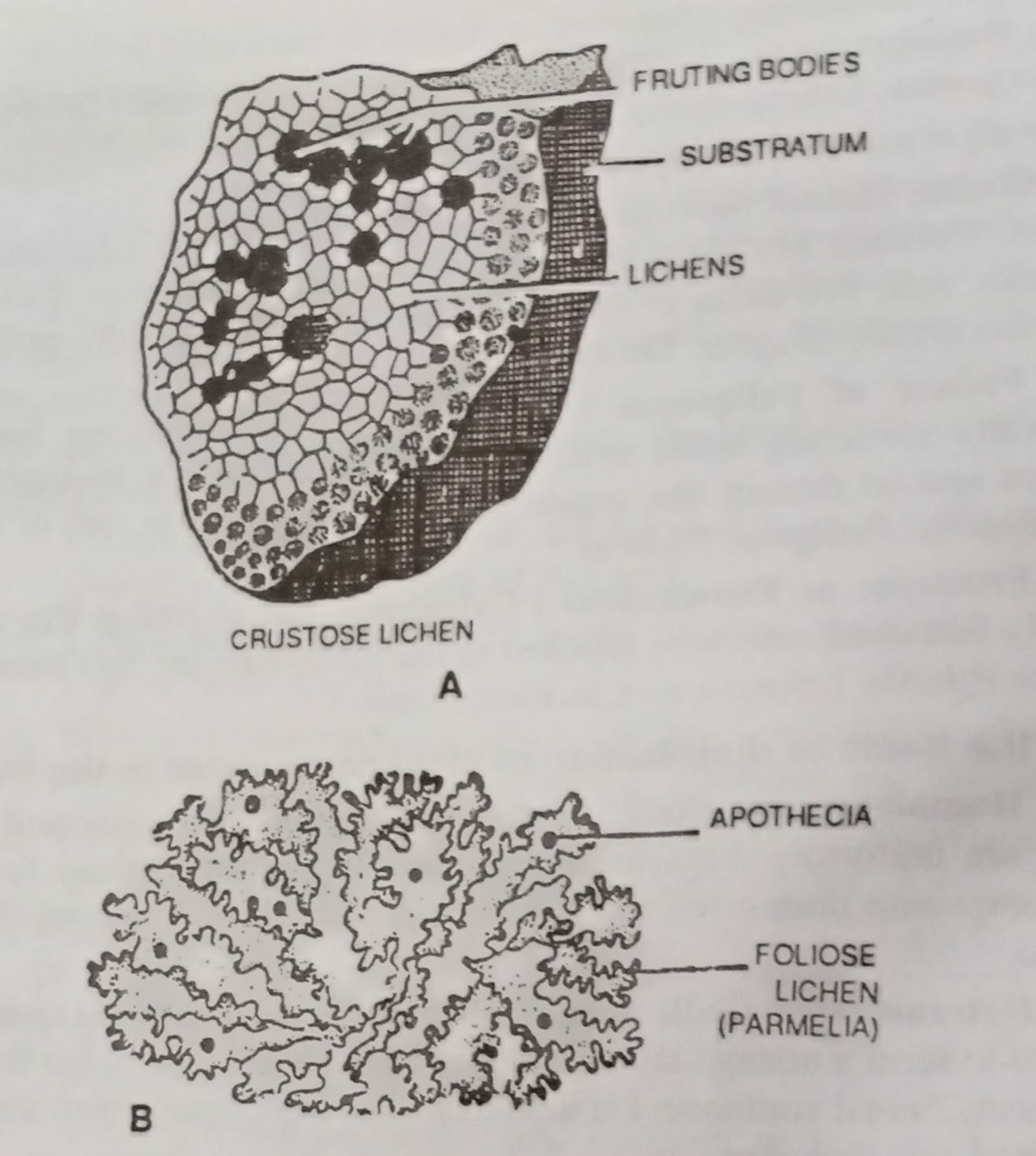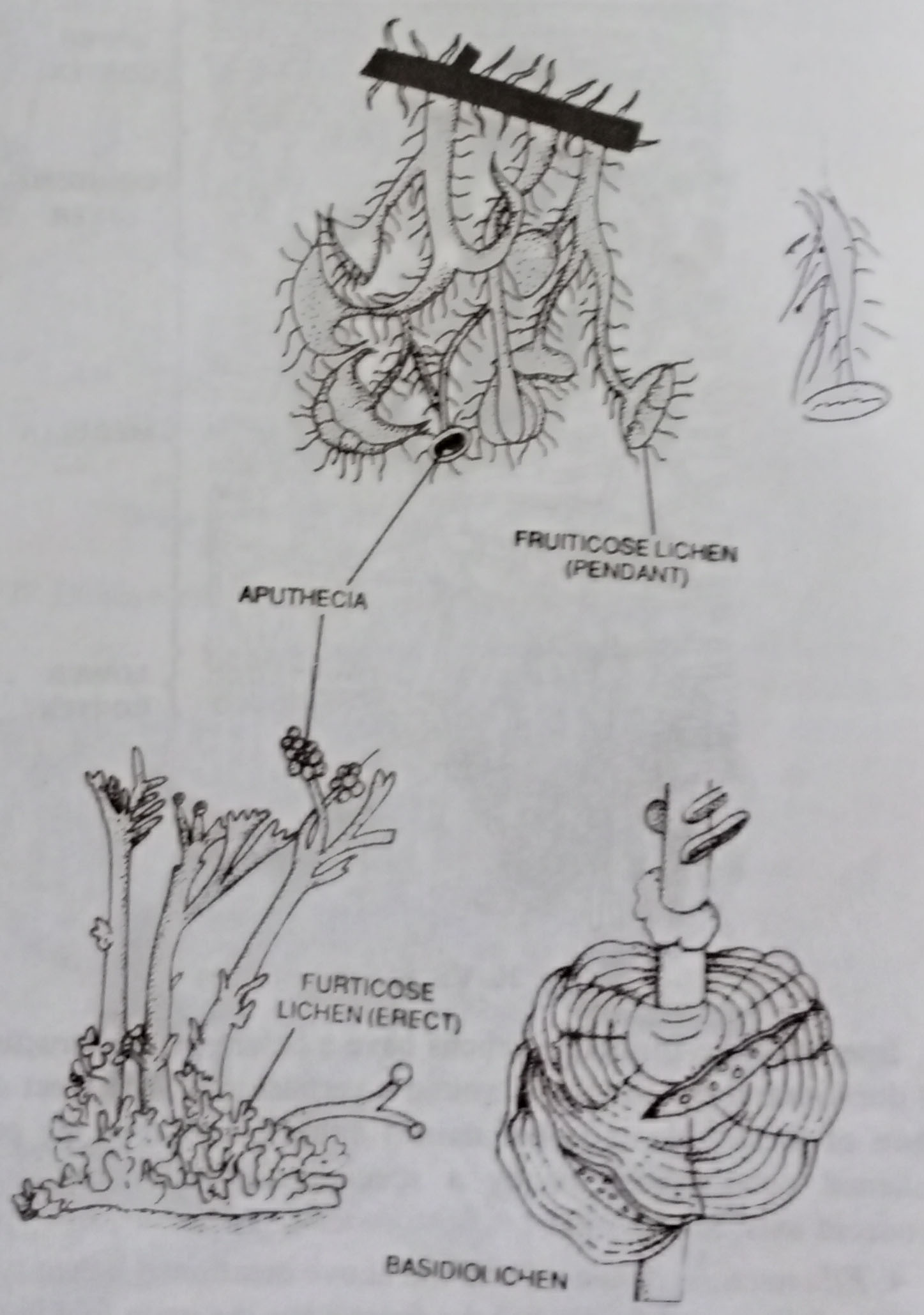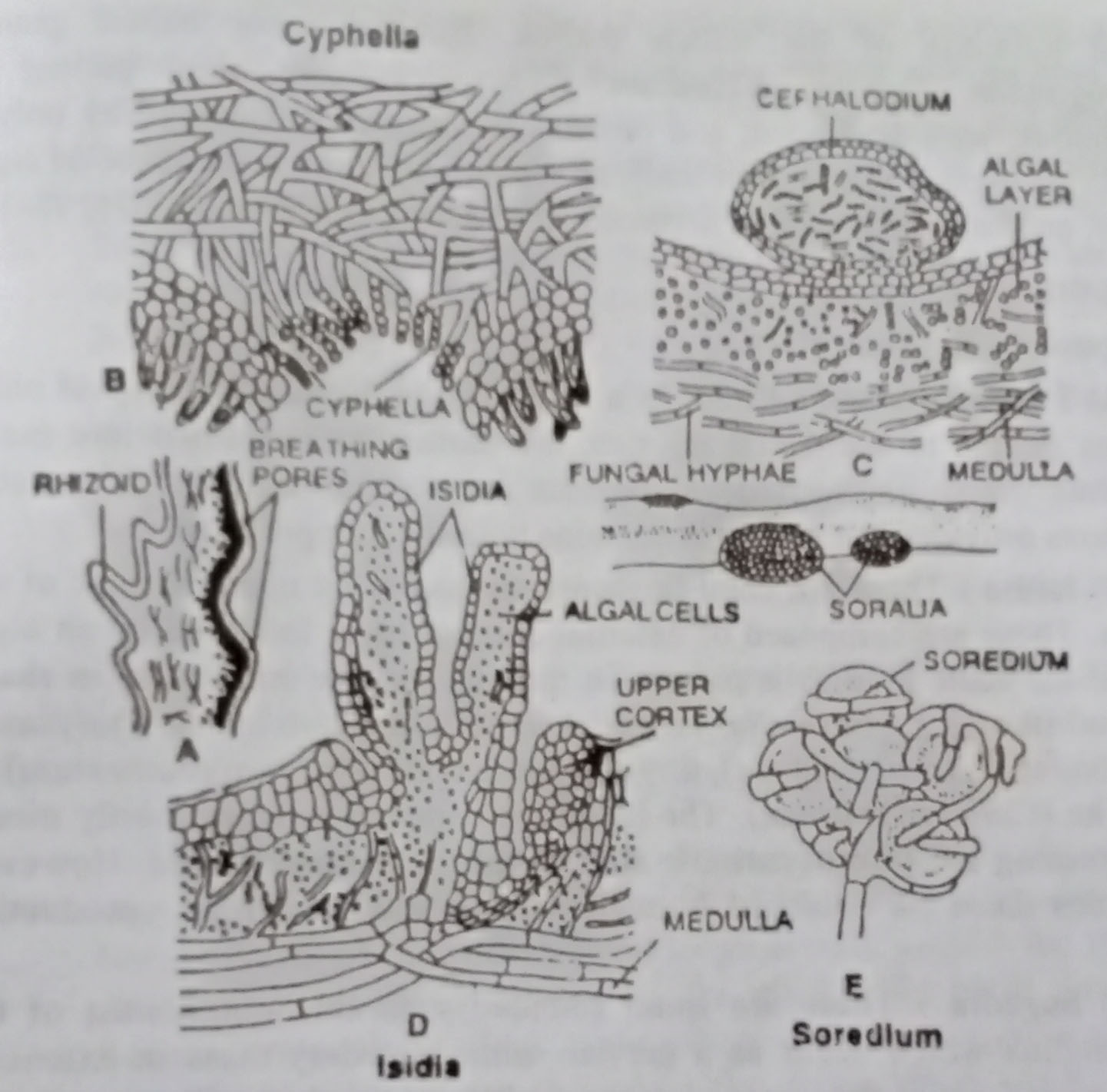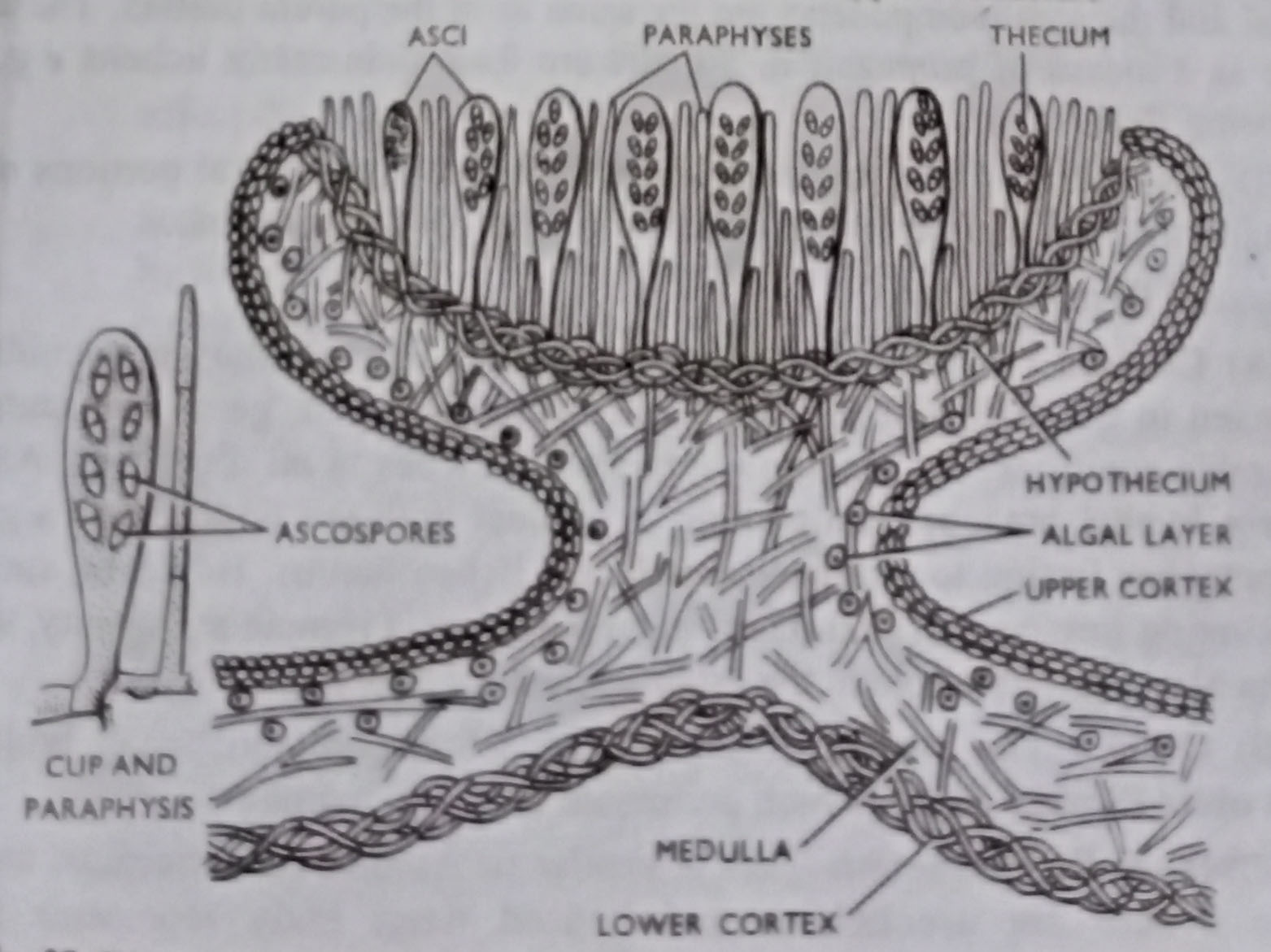BSc 1st Year Botany Lichens Sample Model Practice Question Answer Papers
BSc 1st Year Botany Lichens Sample Model Practice Question Answer Papers: BSc is a three-year program in most universities. Some of the universities also offer BSc Honours. After getting enrolled for BSc, there are certain things you require the most to get better grades/marks in BSc. Out of those, there are BSc Study Material, BSc Sample Model Practice Mock Question Answer Papers along with BSc Previous Year Papers. At gurujistudy.com you can easily get all these study materials and notes for free. Here in this post, we are happy to provide you with BSc 1st Year Botany Lichens Sample Model Practice Question Answer Papers.

Index for BSc 1st Year Botany Lichens Sample Model Practice Question Answer Papers
Structure and Methods of reproduction: Page 1
Economic Importance of Lichens: Page 2
Relationship between the components of lichen thallus: Page 3
Q.1. What are Lichens? Describe briefly their structure and methods of reproduction.
Ans.1. Lichens is a group of plant, whose plant body is made up of algae as well as fungus both, which live together in an intimate relationship. The relationship is often described as symbiosis. The fungi in lichens are slightly parasitic upon algae cells, from which they obtain food and in turn they help algae in absorption and retention of water. The algal components of lichens are chiefly members of the cyanophyta (blue green algae) and chlorophyata (green algae) the fungi are chiefly ascomycetes rarely basidiomycetes. The science of lichens is termed as lichenology and who studies this science is known as Lichenologists.
“Theophrastus’ was the first to use the term Lichen for superficial growths on the bark of olive trees. Schwendener (1867) gave dual hypothesis which postulates composite nature of lichen thallus to be composed of forms resembling algae and fungi. He defined lichen as fungi parasitizing algae. Reininke (1872) described the connection between the fungus and algae as consortium i.e., association in which both partners have mutual growth and interdependance.
De Bary (1879) took up this idea of mutual advantage still further and proposed the word symbiosis. Crombi (1885) described this association as the unnatural association, between the captive algal damsel (slave) and a tyrant fungal master i.e., association decidedly at the expense of the alga. This association is called Helotism. (BSc 1st Year Botany Lichens Sample Model Practice Question Answer Papers)
Occurrence
Lichens are widely destributed and grow in different habitats. The occur in abundance on the shady sides of tree trunks, rooks, logs of wood. There are nearly 100 genera and 1500 species of lichens. A few lichens survive in frozen state of arctics. Rarely they are marine. In India Lichens occur all over Himalayas and higher hills of penisular India.
Lichens have been described as “perennial aerial plants of somewhats lowly organization”. They are in the form of spreading encrustation. Horizontal leafy expansions or upright straphaped fronds or pendulous filaments on tree trunks, walls, rocks, soil from sea shores to high mountain tops. They are mostly perennial, aerial, slow growing and long lived plants. They grow even in areas which appear unsuitable for normal plant growth. viz., bare hard rocks and cold arctic regions. They generally do not thrive well near large cities where atmosphere is polluted by smoke. They may be white, yellow, brown, gray or even black.
Based on the type of habitat colonised, the lichens may be grouped into following categories:
(i) Corticalous– developing on the bark of trees. Examples- Usnea,
Grahis, Alectoria, species of Parmelia.
(ii) Lignicalous– developing on wood directly. Examples- Calicium,
Chaenotheca, Cyphelium.
(iii) Saxicalous– developing on rocky substrata. Examples- Dermatocarpon, Porina, Verrucaria, Xanthora, etc.
(iv) Terricalous– growing on the ground. Examples-Lecidea granulosa, Cladonia floerkeana, Collema tenax, etc.
(v) Marine- developing on siliceous rocky shore of sea. Examples- Daloplaca marina, Verrucaria mucosa.
(vi) Fresh water– developing on hard siliceous rocks in fresh water. Examples- Hymenelia lacustris.
In India, the lichens are much more common in Eastern Himalayas as compared to that in the Western Himalayas. Darjeeling, Gangtok and places upto 10,000 feet enroute to Jemu glacier in Sikkim are ideal for lichen collection.
CLASSIFICATION
The lichen have been variously classified based on three important criteria as follows.
- On the basis of their fungal component-The lichens are divided into two subclasses
- Ascolichens: Where the fungus is an ascomycete. Most lichens are ascolichens. Ascolichens are further divided into two parts-
(a) Gymnocarpeae: Fruiting body is apothecium.
(b) Pyrenocarpeae: Fruiting body is perithecium.
The algal component of ascolichen is either a member of Myxophyceae (Cyanophyceae) i.e., blue green algae or Chlorophyceae-green algae
- Basidiolichens: Where the fungal component belongs to Basidiomycetes. There are only three genera in this group.
The algal partner is always a member of Myxophyceae.
- On the basis of the type of thallus-The lichens are divided into three types-
- Crustose of Crustaceous: The lichen occur as thin or thick crust over rocks, soil, tree barks in which it is partially or completely embedded. e.g., Rhizocarpon, Graphis, Lecanora.
- Foliose of Foliaceous: Leafy lichens which are leaf like horizontally spreading lobed structure which attach to the substratum by means of special rhizoid like organs developed from lower side of thallus. e.g., Parmelia, Peltigera, Physcia.
- Fruticose or Filamentous: Cylindrical, flat or ribbon like upright generally branched structures attached to the substratum by their basal ends. They are shrubby lichens e.g., Cladonia, Usnea.
III. On the basis of distribution of algal component in the thallus
- Homolomerous thalli: In this thallus the algal cells and fungal hyphae are uniformly dispersed throughout the thallus. In these forms the algal component dominates and is usually a member of Myxophyceae e.g., Collema.
- Heteromerous thalli: Thalli in which the algal cells are restricted or confined to form a distinct layer generally on the upper side of the thallus. In these forms fungal component is dominant. The algal component is usually a member of chlorophycae.
LICHEN THALLUS (Morphology and Anatomy)
The association of the mycobionts and the photobionts in the lichens results in the formation of a thallus-type plant body. In general, the lichen thallus is irregular, variously coloured, and shows several morphological types.

Formerly only three basic types (crustose, foliose and fruticose) of lichen thalli were recognized. But, on the basis of their detailed studies, Hawksworth and Hill (1984) described the following categories and subcategories in the morphology of the lichen thallus:
- Leprose lichens: This is the simplest type of thallus organization, in which the fungal hyphae envelope either single or small cluster of algal cells. A distinct fungal layer does not envelope the algal cells all over. The so-formed simple lichen thallus grows superficially over the substratum, provides a powdery appearance, and is called leprose, e.g., Lepraria incana.
- Crustose lichens: In these lichens (Buellia, Strigula, Dimerella, Graphis) the thallus is very closely adhered to the substratum, and provides a crust-like appearance. It is very difficult to separate them from the substratum. The photobiont (algal) cells are covered by a distinct layer of fungal tissue (cortex).
In crustose lichens the outer surface is smooth, and may be continuous or dissected by wandering cracks. In some genera, such as Rhizocarpon, the outer surface contains many polygonal structures, called areolae. When the areolae grow out to form coralloid tufted chshions, they are called suffruticose.
Some variations of the crustose types are mentioned below:
- Placodioid: When the outer surface is radially striate and contains slight raised marginal tissues, the lichen is called placodioid or placoid, e.g., Lecanora and Caloplaca.
- Squamulose: When the outer surface contains overlapping scale-like squamules, the crustose-lichen is called squamulose e.g., Psora.
Internally a crustose lichen is usually differentiated into cortex, algal zone and medulla. The cortex and medulla are made up of fungal hyphae. Some hyphae of the medulla may form pointed rhizoids, which enter into the substratum.
- Foliose lichens: The thallus is flat, leaf-like, well-branched, lobed, and attached to the substratum with the help of rhizoid-like rhizines. The external appearance is like that of crinkled and twisted leaves, e.g., Parmelia, Physcia, Collema, Peltigera, etc.
Internally, along with the presence of a separate upper cortex on the upper side followed by an algal layer and a thick medulla, foliose lichens also have a well organized lower cortex. From some cells of this lower cortex develop rhizines or some other type of attachment organs. The regions of the upper cortex, medulla and lower cortex are formed by the fungal hyphae.

Foliose lichens may fall into any of the following categories (Hawksworth and Hill, 1984):
- Homolomerous: The algae in some lichens are distributed more or less evenly throughout the thallus, as in Collema. Such lichens are called Homolomerous.
- Heteromerous: The algal cells in majority of the foliose lichens form a distinct layer (algal zone) within the thallus. Such lichens are called Heteromerous e.g., Parmelia, Physcia, etc.
- Fruticose lichens: These are well-branched, generally erect or pendulous structures, which provide shruby appearance, e.g. Usnea, Cladonia, Letharia, Bryoria, etc.

Internally the fruticose lichens have a heteromerous structure, which is not dorsiventral but develops around a vertical axis. The erect or pendulous nature of these lichens is maintained either because of the presence of a thickened outer cortex or by a specialized central elastic axis, called chondroid axis, as in Usnea.
- Filamentous lichens: In all the above mentioned lichen types (leprose, crustose, foliose and fruiticose) the fungus has the main role in the formation of the structure of the lichen thallus.

But in some lichen genera (Coenogonium, Ephebe, Racodium, Cystocoleus) the algal partner is filamentous, well developed, and remains ensheathed or covered by only a few fungal hyphae. The lichen thalli so formed have the dominance of algal partner, and have been named filamentous by Hawksworth and Hill (1984).
Reproduction
1. Vegetative Reproduction
(A) Fragmentation: Either as a result of the death and decay of older portions or due to accidental injuries, the thallus breaks down into many fragments. Each fragment develops into a new thallus under favourable conditions provided the fragment contains both the components.
(B) Isidia: These are coral-like outgrowths on the upper surface of the lichens. These are composed of external cortical layer followed by an algal layer of the same kind as is present in the thallus. The isidia vary in shape from rod-like (e.g., Parmelia saxatilis), coralloid (Umblicarta Pystykata), cigar-shaped (Usnea composa), tiny coral-like buds (Peligera praetextata) or scale-like (Collema crispum). The isidia are believed to be primarily meant for increasing the photosynthetic surface of the lichen thallus. However, sometimes these are detached from the thallus and behave as reproductive bodies.
(C) Soredia: These are small rounded separable outgrowths of the lichen thallus which occur as a greyish white powdery mass in extensive patches usually over the upper surface of edges of the thalli. The soredia are composed of algal cells clasped and surrounded by fungal hyphae. Both the fungal and the algal components are the same as in the parent thallus. These serve as a means of propagation. Soredia are formed in many lichens eg. Parmelia, Bryoria.
(D) Phyllidia: These are leaf-like or scale-like dorsiventral portions of the entire thallus of some foliose lichens e.g., Peltgera praetextata.
2. Asexual Reproduction
(A) Conidia: Many lichens produce conidia in flask-shaped pycnidia immersed in the thallus. The conidia, on being dispersed, germinate under favourable conditions by sending out hyphal branches in all directions. Any of these hyphal branches, on coming in contact with the appropriate algal cell, branches further to ultimately produce a lichen thallus. However, since their coming into contact with right algal partner is a remote possibility, the conidia play negligible role in the establishment of new lichen thalli.
(B) Oidia: The hyphae of some lichens break up into small bodies called oidia (Smith, 1921), which germinate into new hyphae.
3. Sexual Reproduction-This is similar to Ascomycetes because most of the lichens are ascolichens and henced fungi body represents the ascomycetations nature. Thus frutification like apothecia and perithecia occur in lichens as the end products of sexual reproduction. The female reproductive organ is called carpogonium it is coiled and multicellular the male organ is a flask shaped structure and is called as spermogonium. It produces non-motile spermatia.
The male nucleus fuses with female nucleus. The fusion cell produces ascogenous hyphae within which develop 8 ascopores, and asci. The hymenium, is made up of asci and paraphysis. The hymenium is made up of asci and paraphysis. The fruiting body may be either as apothecia or perithecia. Their fruiting body may be either an apothyecia or perithecia.
BSc 1st Year Botany Lichens Sample Model Practice Question Answer Papers